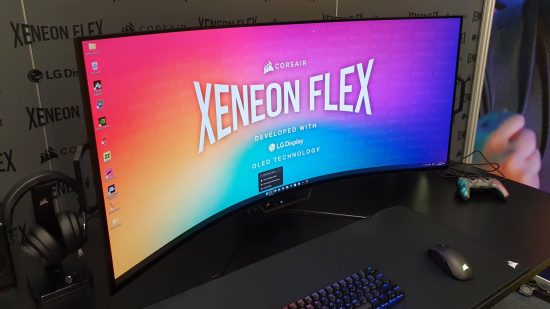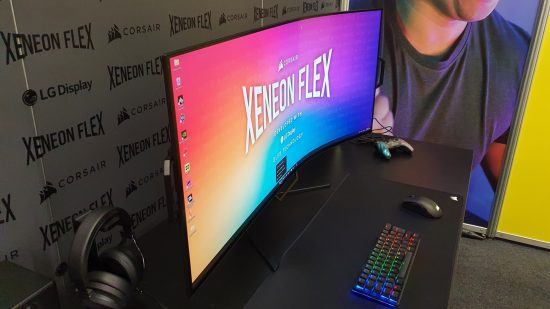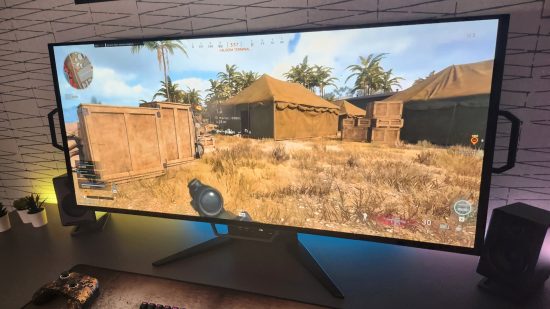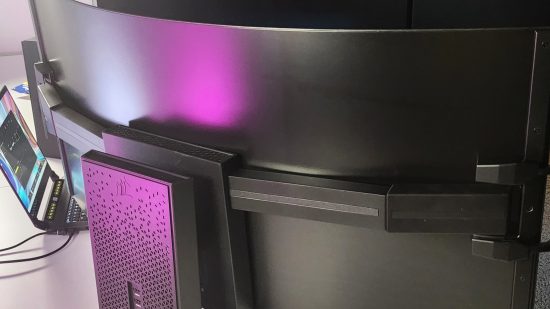Corsair marked a new milestone in foldable technology recently by announcing the world’s first gaming monitor where you can adjust the curvature to your liking. This is all thanks to a new LG panel that’ll also grace upcoming gaming TVs, but it has us wondering… why? The ability to bend a monitor to your will is an impressive feat and you’ll certainly be the envy of your friends until the wow-factor wears off, but does the feature give you an advantage over static alternatives?
As its name suggests, the Corsair Xeneon Flex 45WQHD240 is similarly kitted out to the best gaming monitor. It’s a 45-inch ultrawide gaming monitor with a 1440p resolution and 240Hz refresh rate. It also packs 0.03ms response time, a 1,000nits brightness, and is the brand’s first OLED panel. I find it far more vibrant than the Corsair Xeneon 32UHD144, but with OLED gaming monitors releasing left, right, and centre, the real headliner is its ability to bend.
How it works
Bending the monitor works by grabbing the retractable handles either side of the display and pulling them closer together. Since we got our hands on a prototype model, things might change before it hits the market, but currently the process isn’t the smoothest.
The screen is quite stiff, meaning you tread the fine line between manhandling the monitor to flatten or bend it, while not putting any pressure on the screen itself. Corsair assures us that the display is robust, but much like my first experiences with the Samsung Galaxy Z Flip 4, it’ll take some time before my stomach stops sinking and bending becomes second nature.
There are no prerequisites to bending it, meaning you don’t need to flick the power off before you start folding. Corsair includes a crunch-like click that lets you know when you’ve reached your 800R curve limit, which might add to your fear of breaking it but serves to do the opposite. You’ll probably want to pop your gaming headset off to do this, though, as it’s not tactile and the sound is easily drowned out by chatter.
Who’s it for?
Stefan Quiring, Corsair’s European junior PR specialist, tells us that the Flex is “a special use-case” in that you can immerse yourself in UI elements while curved, much like he does playing Forza Horizon 5 in cockpit mode, or opt to flatten the screen when you work. The reason behind this is that “it’s easier to follow a line of text on a flat screen” without the distortion or shadows that curved brings with it – or so we’re told.
While I regularly pull my monitor closer to compensate for my competitively worn eyes when I play Rainbow Six Siege, I’ve never felt the urge to swap my screen from flat to curved or vice versa – and I regularly work from the same gaming PC I play on. Even after stepping into Master Chief’s shoes in Halo Infinite, I still feel as though the Corsair Xeneon Flex answers a question no one really asked – but there is science behind it.
Conforming to the shape of your eyes, curved monitors offer greater immersion with a better perceived field of view because it lessens the distorted edges that come with flat screens. When we use the term ‘distorted’ here, it’s not about the quality of image that a monitor produces on the outer edges of the display, but rather how your peripheral vision sees the image when you’re focused on the centre of the screen.
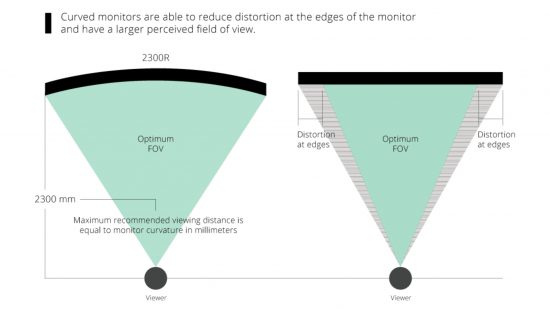
Image credit: ViewSonic
You strain less to interpret the peripheral images, meaning less fatigue and more comfort when gaming. This is particularly true of FPS games, as it makes your peripheral vision more reliable so you focus on the central crosshair rather than your eyes darting around the screen to find the enemy.
The downsides to curved screens are few and far between, but the main thing is that they’re not quite as friendly for groups. The curves make gathering around the monitor that much more difficult to see what’s going on, distorting what you’re watching or playing unless you’re positioned directly in front of it. They also aren’t quite as good at handling text on the screen compared to flat options, as the font can warp and cause your eyes to strain more when reading. And finally, they’re harder to position on your gaming desk to avoid glare from the windows and RGB lights around your room, given the surface area faces several different directions at once.

Is the Corsair Flex worth it?
The Corsair Xeneon Flex’s value squarely lies in its price tag, which we don’t yet know. Corsair has already cut costs by making this a manual process rather than motorised – also avoiding a potentially unnecessary point of failure – but it’s likely the new feature will come with an added premium attached. No matter what the cost ends up being, however, it makes some concessions you might not be happy with.
First is the lack of mounting options, as the Flex technology limits you to the stand it comes with. Fortunately, this stand includes a swanky hub of ports that are more accessible than those shoved behind the display and Corsair is working on a proprietary solution to let you clamp the monitor to your desk, but it can be a deal breaker if you don’t like two feet sticking out and into your mouse pad.
You’ll also struggle to fit the Flex into a multi-monitor setup, as you don’t want anything obstructing the handles that allow you to bend the curve. You could stack them above, and you might not even see the need for a second screen given this one’s a whopping 45-inches, but that’s down to personal preference.
If you can get past these obstacles, then credit where it’s due as no gaming monitor out there ticks all the boxes that the Corsair Xeneon Flex 45WQHD240 does. It’s vibrant, speedy, smooth, and one-of-a-kind. Still, competition is heating up from LG UltraGear, Asus ROG, and Samsung Odyssey. Everything rests on that final MSRP, and the $1,499.99 USD price tag latched onto the LG UltraGear 48GQ900 for lower specs doesn’t fill us with confidence that this will be attainable for anyone but professionals.
